NoooThere's a lot of damage. A lot of white skeleton showing. You can't bring 7alk up to 8 right Away. 7.5 might be safe. This could be polyp bail out
Navigation
Install the app
How to install the app on iOS
Follow along with the video below to see how to install our site as a web app on your home screen.
Note: This feature may not be available in some browsers.
More options
You are using an out of date browser. It may not display this or other websites correctly.
You should upgrade or use an alternative browser.
You should upgrade or use an alternative browser.
Help! Why is my Aussie torch shriveling up all of a sudden?
Okay, I'll give that a try. Also going to re-test my alk just to be sure it was correct.Slowly raise alk levels. Maybe reduce lighting a bit
Im not experienced in much on much in reefing but if say was splitting,i would off thought it would off started going the shape it is going? Im asking a question btw
But dont take what i say as like hope and dont try look to solve problem which im sure you wont after me saying i dont know much about much lol( if there even is one that is.but i do see the right side on one your pics more skeloton showing,so im guessing this what some looking at correct? Sorry im trying to learn as much as i can
But dont take what i say as like hope and dont try look to solve problem which im sure you wont after me saying i dont know much about much lol( if there even is one that is.but i do see the right side on one your pics more skeloton showing,so im guessing this what some looking at correct? Sorry im trying to learn as much as i can
Attachments
-
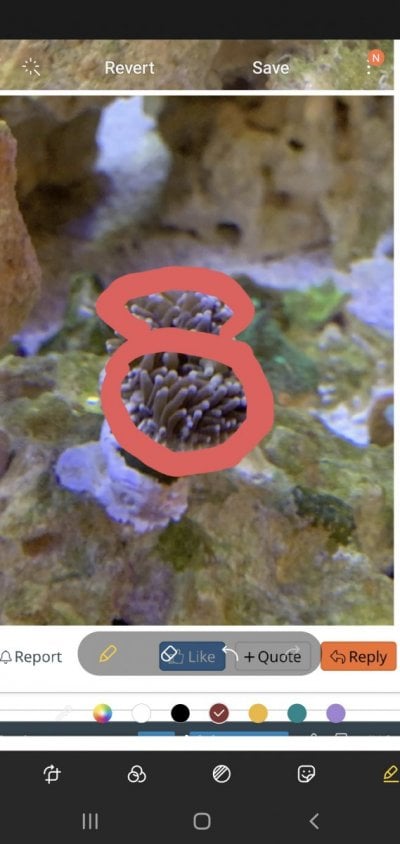 Screenshot_20210806-010040_Photo Editor.jpg89.5 KB · Views: 34
Screenshot_20210806-010040_Photo Editor.jpg89.5 KB · Views: 34 -
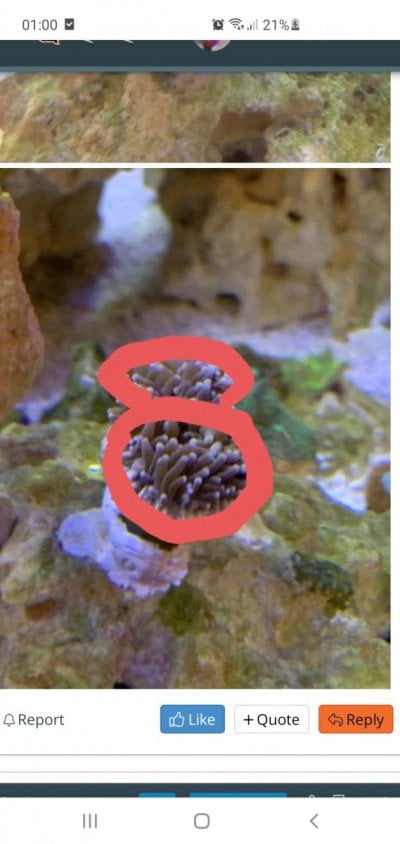 Screenshot_20210806-010005_Chrome.jpg93.5 KB · Views: 47
Screenshot_20210806-010005_Chrome.jpg93.5 KB · Views: 47 -
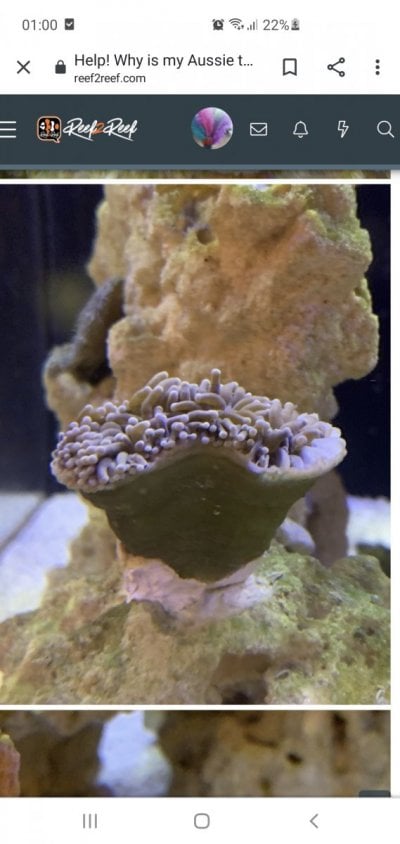 Screenshot_20210806-010056_Chrome.jpg95.6 KB · Views: 48
Screenshot_20210806-010056_Chrome.jpg95.6 KB · Views: 48 -
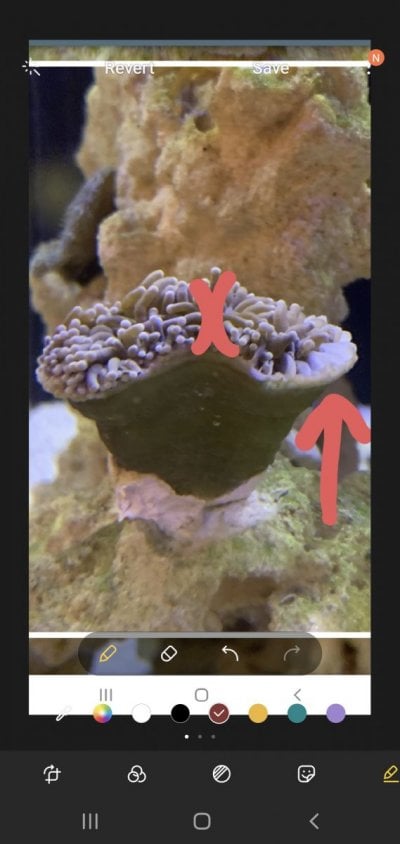 Screenshot_20210806-010208_Photo Editor.jpg84.2 KB · Views: 57
Screenshot_20210806-010208_Photo Editor.jpg84.2 KB · Views: 57 -
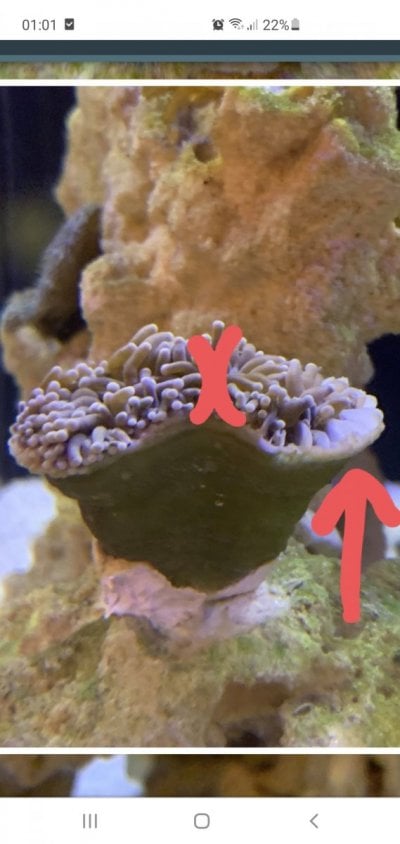 Screenshot_20210806-010114_Chrome.jpg95.2 KB · Views: 44
Screenshot_20210806-010114_Chrome.jpg95.2 KB · Views: 44
I have never seen a coral do this. It left behind the base tissue tearing itself up.Im not experienced in much on much in reefing but if say was splitting,i would off thought it would off started going the shape it is going? Im asking a question btw
But dont take what i say as like hope and dont try look to solve problem which im sure you wont after me saying i dont know much about much lol( if there even is one that is.but i do see the right side on one your pics more skeloton showing,so im guessing this what some looking at correct? Sorry im trying to learn as much as i can
Ok fair enough.i will look up how torches actually split.all i know is 1 head becomes 2 ^_^I have never seen a coral do this. It left behind the base tissue tearing itself up.
Aussies have trouble in warmer water from my experience.
It does look like it's on the way out.
An Iodine dip would be about all I would do.
You can try a stronger dip to see if worms are eating the inside.
It does look like it's on the way out.
An Iodine dip would be about all I would do.
You can try a stronger dip to see if worms are eating the inside.
What would the ideal temp be? This is pretty much what the tank is always like, with very small point fluctuations. I've had the torch for 2 months, with no sign of stress beforehand.Aussies have trouble in warmer water from my experience.
It does look like it's on the way out.
An Iodine dip would be about all I would do.
You can try a stronger dip to see if worms are eating the inside.
I'm leaning toward the alk being the possible culprit from some of the previous responses...I tested again and confirmed it's at 7.1 currently. Normally it's at 8, and I get my water from my LFS for the time being, so I tested my other container of water I got for another small tank I'm starting and the alk was only 7.6, which I feel like must be low from what it normally is.
There are a lot of issues that could be making it mad and inevitably making it die.What would the ideal temp be? This is pretty much what the tank is always like, with very small point fluctuations. I've had the torch for 2 months, with no sign of stress beforehand.
Stability is key
A swing in 1dkh won't kill a torch
But a swing of 1 dkh with other issues going on in the tank could 100% be the final cause.
A lot of aussie torches come from areas that are connected where the fresh water enters.
The water is in the low 70s and much dirtier.
Maybe the newer imports will have better luck.
I have 1 aussie joker that I got to try and right now and I'm still up in the air if it will bail or not haha
vetteguy53081
Well known Member and monster tank lover
View Badges
Partner Member 2024
Excellence Award
Reef Tank 365
RGB
Article Contributor
Tampa Bay Reef Keepers
West Palm Beach Reefer
Hospitality Award
Ocala Reef Club Member
305 Reef Club
Wisco Reefers
Midwest Reefer
Fish Medic
MAC of SW Florida
Rock Pool Reef Keepers
R2R Secret Santa 2023
My Tank Thread
My Aquarium Showcase
Its more than alk issue. As just mentioned to another torch owner, If you have leather corals, this may be part of the issue. Many leather coral species produce and release toxic chemicals, called terpenes, into the water to protect themselves and to stunt the growth of other species. One of the biggest problems I have seen beginner hobbyists have is failing to account for the calcium demand for these corals. If there is insufficient calcium in your aquarium water, these corals will not be able to make their coral skeleton. You should also never lift a torch coral out of the water if you can avoid it. You could tear the polyps, and torn polyps are prone to infection followed by necrosis
Torch require typical parameters including a temperature around 78 degrees, a specific gravity of about 1.025, ph of about 8.2, and a calcium level of about 400 ppm. Like most large polyp stony corals, a torch coral benefits from moderate water flow. The polyps will remain retracted and under-inflated if the water current is too fast because the large flowing polyps are prone to rip and tear in high or ultra-high current environments.
The torch coral is a photosynthetic coral, meaning it has a relationship with symbiotic zooxanthellae (single-cell photosynthetic organisms) that live inside its tissues that converts the light energy into sugar. In exchange for a home inside the coral, the zooxanthellae split their harvest and feed the coral. Therefore, it is possible to keep the Torch coral without any feeding at all. However, all corals are animals, and animals are meant to eat.
The best placement for a torch coral is in a location that gets moderate water flow and moderate-intensity lighting. Torches are aggressive corals that protect themselves by wielding their sweeper tentacles maliciously. Sweeper tentacles are specialized tentacles that extend much larger than the typical tentacles and are equipped with stinging cells. Torches will send out these long tendrils to zap anything nearby within reach.
Torch require typical parameters including a temperature around 78 degrees, a specific gravity of about 1.025, ph of about 8.2, and a calcium level of about 400 ppm. Like most large polyp stony corals, a torch coral benefits from moderate water flow. The polyps will remain retracted and under-inflated if the water current is too fast because the large flowing polyps are prone to rip and tear in high or ultra-high current environments.
The torch coral is a photosynthetic coral, meaning it has a relationship with symbiotic zooxanthellae (single-cell photosynthetic organisms) that live inside its tissues that converts the light energy into sugar. In exchange for a home inside the coral, the zooxanthellae split their harvest and feed the coral. Therefore, it is possible to keep the Torch coral without any feeding at all. However, all corals are animals, and animals are meant to eat.
The best placement for a torch coral is in a location that gets moderate water flow and moderate-intensity lighting. Torches are aggressive corals that protect themselves by wielding their sweeper tentacles maliciously. Sweeper tentacles are specialized tentacles that extend much larger than the typical tentacles and are equipped with stinging cells. Torches will send out these long tendrils to zap anything nearby within reach.
Thanks for this really detailed response. A few notes in comparison to your points:Its more than alk issue. As just mentioned to another torch owner, If you have leather corals, this may be part of the issue. Many leather coral species produce and release toxic chemicals, called terpenes, into the water to protect themselves and to stunt the growth of other species. One of the biggest problems I have seen beginner hobbyists have is failing to account for the calcium demand for these corals. If there is insufficient calcium in your aquarium water, these corals will not be able to make their coral skeleton. You should also never lift a torch coral out of the water if you can avoid it. You could tear the polyps, and torn polyps are prone to infection followed by necrosis
Torch require typical parameters including a temperature around 78 degrees, a specific gravity of about 1.025, ph of about 8.2, and a calcium level of about 400 ppm. Like most large polyp stony corals, a torch coral benefits from moderate water flow. The polyps will remain retracted and under-inflated if the water current is too fast because the large flowing polyps are prone to rip and tear in high or ultra-high current environments.
The torch coral is a photosynthetic coral, meaning it has a relationship with symbiotic zooxanthellae (single-cell photosynthetic organisms) that live inside its tissues that converts the light energy into sugar. In exchange for a home inside the coral, the zooxanthellae split their harvest and feed the coral. Therefore, it is possible to keep the Torch coral without any feeding at all. However, all corals are animals, and animals are meant to eat.
The best placement for a torch coral is in a location that gets moderate water flow and moderate-intensity lighting. Torches are aggressive corals that protect themselves by wielding their sweeper tentacles maliciously. Sweeper tentacles are specialized tentacles that extend much larger than the typical tentacles and are equipped with stinging cells. Torches will send out these long tendrils to zap anything nearby within reach.
- I don't have any leather corals - other corals include 2 hammers, a few different mushrooms, 2 duncans, 2 gonis, 1 acan, a couple of stylos, some zoas, and some encrusting corals.
- The torch is on a rock by itself away from all others, mostly so it didn't sting anyone else. It's been in the same spot since I got it, and I've never moved it even on the rock.
- The flow is moderate and the lighting is moderate.
- My calcium is always right around 450, temp is 77-78, salinity typically 1.026, and pH around 8-8.1
Oh man, I hope yours hangs in there! I really like how fluffy they are. Hoping mine will pull through.There are a lot of issues that could be making it mad and inevitably making it die.
Stability is key
A swing in 1dkh won't kill a torch
But a swing of 1 dkh with other issues going on in the tank could 100% be the final cause.
A lot of aussie torches come from areas that are connected where the fresh water enters.
The water is in the low 70s and much dirtier.
Maybe the newer imports will have better luck.
I have 1 aussie joker that I got to try and right now and I'm still up in the air if it will bail or not haha
I'm glad you asked and depicted this so well, as I was wondering the same thing. I hope that whatever is causing the issue is something I can come back from, and then the torch can possibly split like this later on..Im not experienced in much on much in reefing but if say was splitting,i would off thought it would off started going the shape it is going? Im asking a question btw
But dont take what i say as like hope and dont try look to solve problem which im sure you wont after me saying i dont know much about much lol( if there even is one that is.but i do see the right side on one your pics more skeloton showing,so im guessing this what some looking at correct? Sorry im trying to learn as much as i can
vetteguy53081
Well known Member and monster tank lover
View Badges
Partner Member 2024
Excellence Award
Reef Tank 365
RGB
Article Contributor
Tampa Bay Reef Keepers
West Palm Beach Reefer
Hospitality Award
Ocala Reef Club Member
305 Reef Club
Wisco Reefers
Midwest Reefer
Fish Medic
MAC of SW Florida
Rock Pool Reef Keepers
R2R Secret Santa 2023
My Tank Thread
My Aquarium Showcase
Nutrients added are a possibility as they could be elevating nitrates and/or PHOS. Assure you are NOT getting false salinity readings by calibrating your salt testerThanks for this really detailed response. A few notes in comparison to your points:
If the alk can't be the only issue, could it be the Red Sea nutrients? It's the only change I've made in the tank at all, and all of my parameters aside from the alk are right where they normally are, so stable. I would have thought adding that would be a benefit, but perhaps it could have caused some harm??
- I don't have any leather corals - other corals include 2 hammers, a few different mushrooms, 2 duncans, 2 gonis, 1 acan, a couple of stylos, some zoas, and some encrusting corals.
- The torch is on a rock by itself away from all others, mostly so it didn't sting anyone else. It's been in the same spot since I got it, and I've never moved it even on the rock.
- The flow is moderate and the lighting is moderate.
- My calcium is always right around 450, temp is 77-78, salinity typically 1.026, and pH around 8-8.1
Tested the nitrates and phosphates again to ensure the reading was accurate (salifert and Hanna) and recalibrated salt tester and retested with the same reading also.Nutrients added are a possibility as they could be elevating nitrates and/or PHOS. Assure you are NOT getting false salinity readings by calibrating your salt tester
Could the nutrients have had an adverse effect outside of raising nitrates / phosphates?
As someone who is passionate about torches and euphyllia in general (entire tank dedicated to them, with more than 24+ torches and 24+ other euphyllia), there are times when there is nothing we can do to stop the progression that you are experiencing. I've had aussies for 3-4 months up and completely die for no reason, when all the other euphyllia are doing great.
Dipping excessively is only adding insult to injury... I've also realized that putting torches in a DT is a gamble. My fish have destroyed everyone I put in... no not eating, just constantly rubbing up on them and irritating them to complete failure.
Stable parameters (as vetteguy and merkey noted), consistent low flow, consistent low-mod lighting is the key to success. Even then, it's a crap shoot at best.
My best guess is that there is something in the water they came from (bacteria or algae) that we just don't have in our tanks, and that's leading to the loss.
From the first pic, it's clear that there is tissue recession on the skeleton. Once that happens, you may as well consider it done...
Just my 2 cents...
Dipping excessively is only adding insult to injury... I've also realized that putting torches in a DT is a gamble. My fish have destroyed everyone I put in... no not eating, just constantly rubbing up on them and irritating them to complete failure.
Stable parameters (as vetteguy and merkey noted), consistent low flow, consistent low-mod lighting is the key to success. Even then, it's a crap shoot at best.
My best guess is that there is something in the water they came from (bacteria or algae) that we just don't have in our tanks, and that's leading to the loss.
From the first pic, it's clear that there is tissue recession on the skeleton. Once that happens, you may as well consider it done...
Just my 2 cents...
Similar threads
- Replies
- 25
- Views
- 417
- Replies
- 3
- Views
- 272
- Replies
- 6
- Views
- 327
- Replies
- 15
- Views
- 539






















